
soccer ball size guide
Soccer Ball Size Guide: A Comprehensive Overview (Updated November 25, 2025)
Navigating the world of soccer requires understanding ball sizes, ranging from Size 1 to Size 5, each designed for specific age groups and skill levels․
This guide details official regulations,
dimensions, and appropriate uses for each size, ensuring optimal player development and enjoyment on the field․
Soccer ball sizes aren’t arbitrary; they’re carefully regulated to enhance the playing experience and promote skill development at every age․ Commercially, five sizes exist – Size 1 through Size 5 – with each catering to different player capabilities and stages of growth․ The adult-size ball is commonly referred to as a Size 5․
Understanding these distinctions is crucial for coaches, parents, and players alike․ Using the correct size ball impacts control, passing accuracy, and overall enjoyment of the game․ Smaller balls are often introduced to younger players to build confidence and technique, while the standard Size 5 is employed in competitive, professional matches․ This guide will delve into the specifics of each size, providing a comprehensive overview to help you choose the right ball for your needs․
Understanding Official Regulations
Official soccer ball regulations, primarily governed by FIFA, dictate precise specifications for size, weight, and pressure․ A regulation ball must be spherical and constructed from suitable material․ Crucially, the circumference must fall between 68 cm (27 inches) and 70 cm (28 inches), and the weight between 410 g (14 oz) and 450 g (16 oz)․
Proper inflation is also paramount, typically ranging from 8․5 to 15․6 PSI․ These standards ensure fair play and consistent performance across all levels of competition․ Deviations from these regulations can render a ball unsuitable for official matches․ FIFA implements quality standards to verify compliance, guaranteeing a consistent playing experience for athletes worldwide․ Adhering to these rules is fundamental to the integrity of the sport․
Size 5 Soccer Balls: The Standard for Competitive Play
Size 5 soccer balls represent the pinnacle of the game, serving as the standard for players aged 12 and up, including professionals․ These balls boast a circumference of 27-28 inches, delivering the familiar feel expected in competitive matches․ The larger size demands greater strength and technique, fostering skill development in older players․
An adidas Size 5 pro ball exemplifies the quality expected at this level․ Utilizing this size ensures consistency across leagues and tournaments․ Size 5 balls are not merely larger; they contribute to the strategic and physical demands of the sport, making them essential for serious players aiming to excel․ They are the benchmark for official play․
Age Range for Size 5 Balls
The Size 5 soccer ball is specifically designed for players aged 12 and older, extending all the way to the professional ranks․ This age range signifies a level of physical and technical maturity where players can effectively handle the ball’s larger size and weight․ Younger players may find a Size 5 challenging to control, potentially hindering skill development․
While some leagues might utilize Size 5 balls for slightly younger, exceptionally skilled players, it’s generally recommended to adhere to the 12+ age guideline․ This ensures a fair and developmentally appropriate experience for all participants․ Transitioning to Size 5 marks a significant step in a player’s soccer journey, mirroring the equipment used in high-level competition․
Circumference and Weight Specifications of Size 5
Official Size 5 soccer balls must adhere to strict specifications to ensure fair play and consistent performance․ The circumference of a Size 5 ball must fall between 68 centimeters (approximately 27 inches) and 70 centimeters (around 28 inches)․ This measurement is crucial for standardized gameplay across all levels․
Furthermore, the weight of a Size 5 ball is regulated, ranging from 410 grams (approximately 14 ounces) to 450 grams (around 16 ounces)․ These precise measurements impact the ball’s flight characteristics and how players interact with it․ Maintaining these standards is vital for competitive integrity, guaranteeing a consistent experience for players and officials alike․
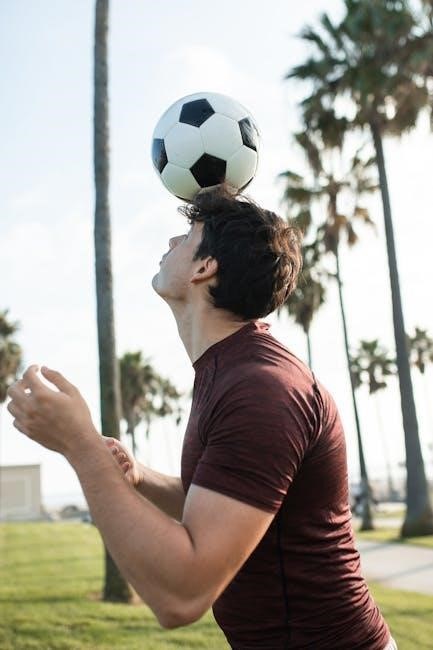
Size 4 Soccer Balls: Bridging the Gap
Size 4 soccer balls serve as a transitional option, effectively bridging the gap between the smaller balls used by younger players and the official Size 5 used in competitive adult play․ These balls are thoughtfully designed to accommodate developing skills and build confidence in intermediate players․ They offer a balance between manageability and the feel of a standard-sized ball․
Utilizing a Size 4 ball allows players to refine their technique without the added challenge of controlling a larger, heavier sphere․ This is particularly beneficial as they progress and prepare for the demands of full-sized matches; They are commonly used in training and recreational settings for specific age groups, fostering a smoother transition to Size 5․
Appropriate Age Groups for Size 4

Size 4 soccer balls are ideally suited for players generally between the ages of 8 and 12․ This age range represents a crucial period of skill development where players are gaining strength, coordination, and a deeper understanding of the game․ The slightly smaller size and reduced weight of a Size 4 ball make it more manageable for these developing athletes․
While individual skill levels vary, this age bracket typically benefits from the increased control and comfort offered by a Size 4․ It allows for more accurate passing, shooting, and dribbling as they build the necessary muscle memory and technique․ Transitioning to a Size 5 too early can hinder progress, while a Size 4 fosters confidence and enjoyment․
Size 4 Dimensions: Circumference and Weight
A Size 4 soccer ball adheres to specific dimensional standards to ensure consistent play across different matches and training sessions․ Officially, the circumference of a Size 4 ball must fall between 63․5 cm (25 inches) and 66 cm (26 inches)․ This reduced circumference, compared to a Size 5, contributes to easier handling for younger players․
Furthermore, the weight of a Size 4 ball is regulated, ranging from 350 grams (12․3 ounces) to 390 grams (13․8 ounces)․ This lighter weight allows for improved control and reduces the physical strain on developing players․ Maintaining these specifications is crucial for fair play and optimal skill development within the designated age groups․
Size 3 Soccer Balls: For Younger Players
Size 3 soccer balls are specifically engineered for the youngest participants in the sport, typically children under the age of eight․ These balls are smaller and lighter than their counterparts, facilitating easier control and promoting a positive initial experience with soccer․ The reduced size allows young players to develop fundamental skills like dribbling, passing, and shooting with greater confidence․
Using a Size 3 ball encourages proper technique from an early age, as it’s more manageable for smaller hands and feet․ This early success builds enthusiasm and fosters a lifelong love for the game․ It’s a crucial stepping stone in a player’s development, preparing them for larger ball sizes as they grow․
Ideal Age Range for Size 3 Balls
Generally, Size 3 soccer balls are most appropriate for children aged eight years and under․ This age group benefits significantly from the reduced size and weight, allowing them to develop essential motor skills and ball control without being overwhelmed․ While individual development varies, most children in this age bracket find a Size 3 ball easier to manipulate and kick effectively․
However, some slightly older or more physically developed children might transition to a Size 4 ball earlier․ Coaches and parents should assess each child’s abilities and comfort level․ The primary goal is to ensure the ball size supports skill development and enjoyment, not to adhere rigidly to age guidelines․ Prioritizing a positive playing experience is key․
Size 3 Ball Specifications: Measurements
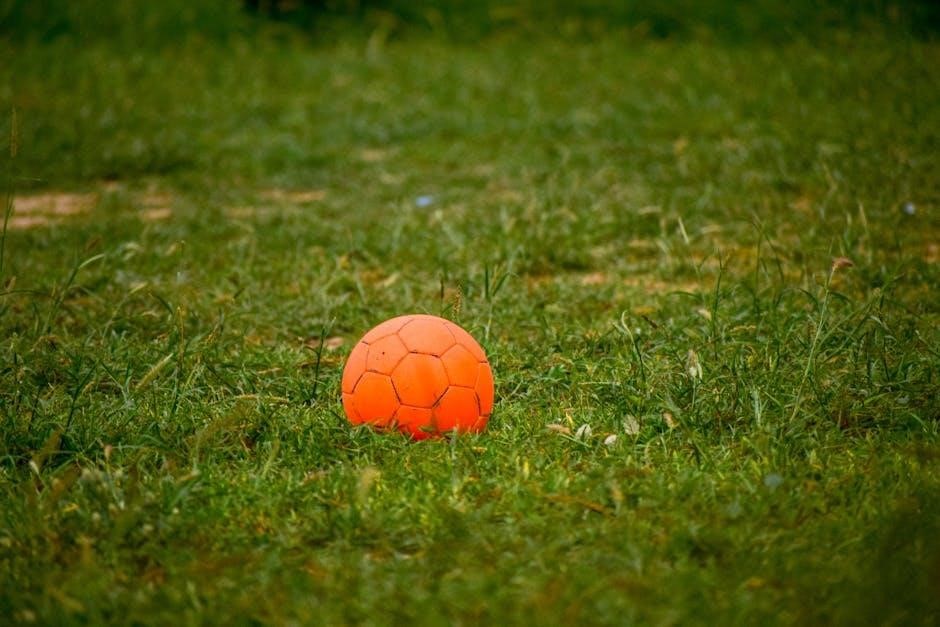
Size 3 soccer balls adhere to specific dimensional standards to ensure consistent play for younger athletes․ Officially, the circumference of a Size 3 ball must fall between 23 and 24 inches (58․5 to 61 centimeters)․ This smaller circumference makes the ball easier for smaller hands and feet to manage․
Regarding weight, a Size 3 ball typically weighs between 11 and 12 ounces (311 to 340 grams)․ This lighter weight reduces the physical strain on young players while still providing adequate control and responsiveness․ Maintaining proper inflation, generally between 8․5 and 15․6 PSI, is crucial for optimal performance and to meet official specifications․ These measurements contribute to a safe and enjoyable playing experience․
Size 2 & Size 1 Soccer Balls: Skills Training & Recreation
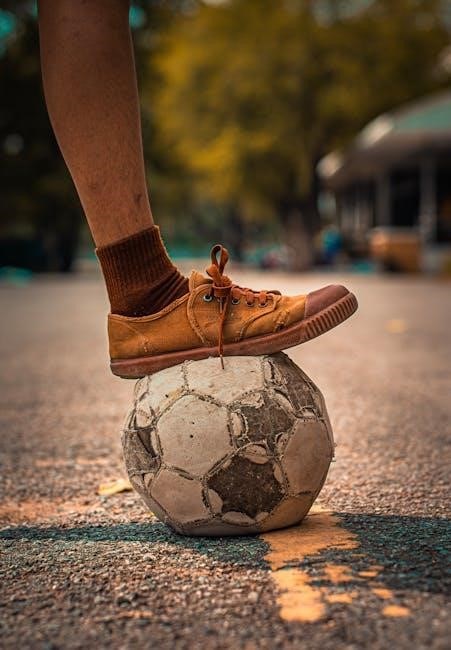
Size 1 and Size 2 soccer balls are primarily utilized for skills development and recreational play, rather than official matches․ These smaller balls are excellent tools for honing close control, dribbling techniques, and footwork, particularly in confined spaces․ Their reduced size and weight allow players to practice intricate maneuvers with greater ease and precision․
They are ideal for indoor training, futsal drills, or simply enjoying a casual kick-around․ Size 1 balls are the smallest, often used for very young children or specialized training, while Size 2 balls offer a slightly larger surface area for developing technique; These balls promote confidence and skill-building in a fun, accessible way․
Uses for Size 1 & 2 Soccer Balls
Size 1 and Size 2 soccer balls excel in a variety of training and recreational scenarios․ They are exceptionally well-suited for individual skill work, focusing on close ball control, rapid footwork drills, and developing a soft touch․ Coaches frequently employ these smaller balls during warm-up exercises to enhance player agility and coordination․
Beyond structured training, they are perfect for casual play in limited spaces, such as indoors or small backyards․ Their compact size minimizes the risk of damage to surroundings and makes them manageable for younger players․ These balls also serve as excellent tools for freestyle soccer, allowing players to experiment with tricks and creative movements, fostering a deeper connection with the game․
Size 1 & 2 Ball Dimensions
Size 1 soccer balls are the smallest available, typically measuring between 18-20 inches in circumference․ Their weight generally falls within the 8-9 ounce range, making them incredibly lightweight and easy to manipulate․ These dimensions are ideal for very young children or focused skill development․
Size 2 soccer balls are slightly larger, with a circumference of approximately 20-22 inches․ They weigh between 10-12 ounces, offering a bit more substance while still remaining manageable for smaller hands and feet․ These balls bridge the gap between Size 1 and larger sizes, providing a stepping stone for developing players․ Both sizes prioritize control and touch over power and distance․
Materials Used in Soccer Ball Construction
Traditionally, soccer balls were crafted from genuine leather, offering a premium feel and exceptional durability․ However, modern soccer balls predominantly utilize synthetic materials like polyurethane (PU) and polyvinyl chloride (PVC)․ PU provides a softer touch, enhanced water resistance, and superior shape retention, making it popular for high-quality match balls․
PVC is a more affordable option, commonly found in training balls․ Beneath the outer layer lies a fabric backing, often composed of polyester or cotton, providing structural integrity․ Multiple layers of backing are laminated together, and a bladder, typically made of latex or butyl, holds the air․ Butyl bladders retain air better than latex, reducing the need for frequent inflation․
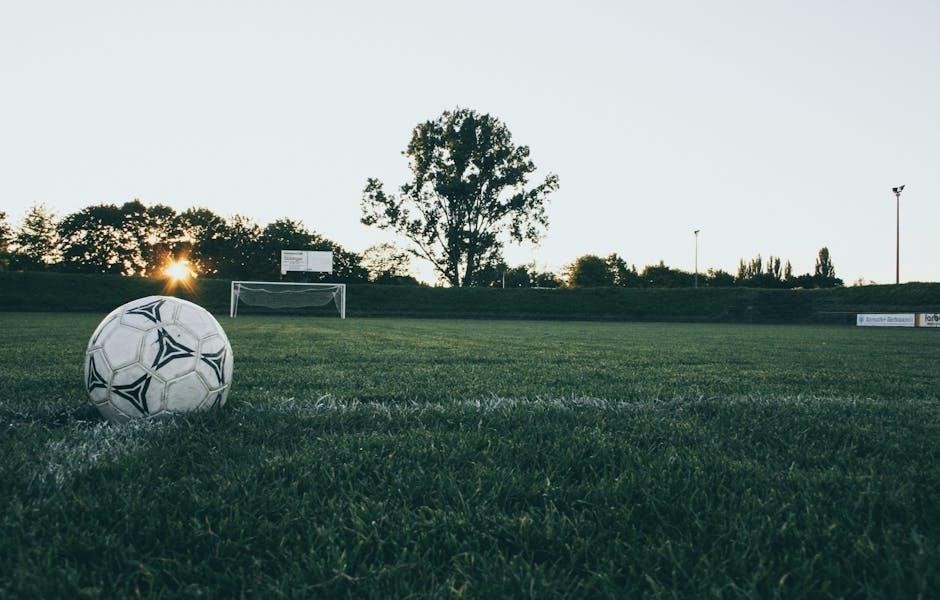
Inflation Pressure: Maintaining Optimal Performance
Proper inflation is crucial for a soccer ball’s performance, impacting its bounce, weight, and overall playability․ Under-inflated balls feel heavy and lack responsiveness, while over-inflated balls become hard and difficult to control․ Recommended pressure varies by ball size and material․
Generally, Size 5 soccer balls require 8․5 to 15․6 PSI (pounds per square inch)․ Size 4 balls typically fall within a similar range, while smaller sizes may need slightly less․ Always check the ball’s manufacturer specifications, often printed near the valve․ Use a reliable pressure gauge to ensure accurate inflation․ Regular pressure checks are vital, as balls naturally lose air over time, affecting performance and potentially causing damage․
Recommended PSI for Different Sizes

Maintaining the correct inflation pressure is vital for optimal soccer ball performance․ Here’s a breakdown of recommended PSI levels for each size․ Size 1 and Size 2 balls, primarily used for skills training and recreation, generally require between 6․0 to 8․0 PSI․ Size 3 soccer balls, ideal for younger players, benefit from a pressure of approximately 7․0 to 9․0 PSI․
Size 4 balls, bridging the gap for developing players, typically perform best at 8․5 to 11․0 PSI․ Finally, the standard Size 5 soccer ball, used for competitive play, demands a pressure range of 8․5 to 15․6 PSI․ Always verify the manufacturer’s recommendations printed on the ball itself, as slight variations may exist․
Match Balls vs․ Training Balls: What’s the Difference?
The distinction between match and training soccer balls lies in construction, durability, and performance characteristics․ Match balls, used in official games, prioritize consistent flight, accurate touch, and water resistance, often featuring thermally bonded seams and high-quality materials․ They are designed for peak performance and visibility․
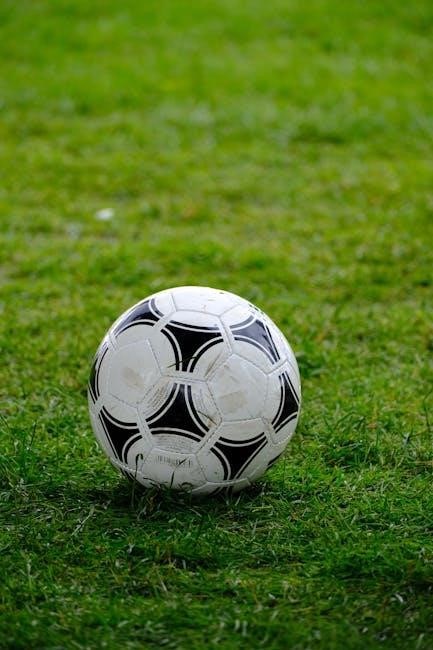
Training balls, conversely, emphasize durability to withstand frequent use and varied surfaces․ They typically employ machine-stitched construction, making them more affordable and robust․ While offering good performance, they may not possess the same precision as match balls․ Both are available in Size 3, Size 4, and Size 5, catering to different age groups and training needs․
FIFA Quality Standards for Soccer Balls
FIFA establishes rigorous quality standards for soccer balls to ensure consistent performance and fair play․ The FIFA Quality Programme and the higher FIFA Quality Pro certification assess balls across numerous criteria, including circumference, weight, rebound, water absorption, and shape retention․
FIFA Quality Pro balls undergo more stringent testing, simulating real match conditions and demanding exceptional consistency․ Balls earning these certifications display official logos, guaranteeing adherence to FIFA’s standards․ These standards are crucial for professional matches and tournaments, ensuring a reliable and predictable playing experience for athletes; Choosing a FIFA-approved ball signifies quality and performance․
Choosing the Right Ball for Different Surfaces
Selecting a soccer ball extends beyond size; surface considerations are vital for optimal play․ Turf surfaces generally suit balls with a textured surface for enhanced grip and control, while natural grass allows for smoother ball movement, benefiting balls with a classic panel design․

Hard surfaces like concrete or asphalt demand durable balls designed to withstand abrasion․ Indoor courts require low-bounce balls to maintain quick gameplay․ Ball construction materials also play a role; synthetic leather excels on various surfaces, while traditional leather is best suited for natural grass․ Matching the ball to the surface enhances performance and longevity․
Soccer Ball Size and Player Development
Proper soccer ball size is crucial for fostering skill development at each age․ Utilizing appropriately sized balls enhances a player’s touch, control, and confidence․ Smaller balls (Sizes 1-3) allow younger players to develop fundamental techniques with greater ease, promoting successful ball manipulation and reducing frustration․
Transitioning to Size 4 bridges the gap, preparing players for the demands of Size 5, the standard for competitive play․ Using a ball too large or heavy can hinder development, impacting technique and enjoyment․ Selecting the correct size ensures age-appropriate challenges, maximizing learning and fostering a lifelong love for the game․
Regulation Soccer Goal Sizes (Related Information)
While focused on ball sizes, understanding goal dimensions provides context for the game’s spatial dynamics․ Regulation soccer goals vary slightly depending on the level of play, but standard dimensions are consistent․ International matches require goals measuring 7․32 meters (8 yards) wide and 2․44 meters (8 feet) high, with depth varying․
Youth games often utilize smaller goal sizes, scaled to the age and skill level of the players․ These reduced dimensions maintain proportional challenges and encourage accurate shooting․ Goalposts and crossbars are typically white, and nets are required for all official matches, ensuring visibility and clear indication of scoring;
Olympic Soccer Regulations (Brief Overview)
Olympic soccer adheres to FIFA’s Laws of the Game, with specific regulations impacting team composition and player eligibility․ Unlike many tournaments, Olympic teams feature primarily Under-23 players, with a limited number of overage players permitted per squad – typically three․ This fosters youth development and provides a platform for emerging talent․
Regarding equipment, Olympic matches utilize FIFA-approved Size 5 soccer balls, meeting stringent quality standards for circumference, weight, and bounce․ Match duration consists of two 45-minute halves, with potential for extra time and penalty shootouts to determine winners in knockout stages․ The competition showcases global soccer prowess on a prestigious stage․
Where to Purchase Soccer Balls
Soccer balls are widely available from numerous retailers, both online and in brick-and-mortar stores․ Major sporting goods chains like Dick’s Sporting Goods, Academy Sports + Outdoors, and Decathlon offer extensive selections, catering to all skill levels and budgets․ Online marketplaces such as Amazon and eBay provide competitive pricing and diverse options, including specialized soccer retailers․
Directly from manufacturers, like Adidas, Nike, and Puma, guarantees authenticity and access to the latest models․ Local soccer specialty shops often provide expert advice and personalized service, assisting in selecting the ideal ball․ Consider price comparison and reading customer reviews before purchasing to ensure quality and satisfaction․
Caring for Your Soccer Ball: Longevity Tips
Proper maintenance significantly extends a soccer ball’s lifespan․ Regularly check the inflation pressure, maintaining the recommended PSI for the ball’s size – typically between 8․5 and 15․6 PSI․ Avoid over-inflation, which can distort the shape and compromise performance․ After each use, wipe down the ball with a damp cloth to remove dirt and debris, preventing abrasion․
Store the ball in a cool, dry place, away from direct sunlight and extreme temperatures․ Avoid storing it in a car during hot weather․ Periodically inspect the ball for cuts or damage, and consider using a ball pump with a pressure gauge for accurate inflation․ Consistent care ensures optimal performance and lasting enjoyment․
Frequently Asked Questions About Soccer Ball Sizes
What size ball do professionals use? Size 5 soccer balls, with a circumference of 27-28 inches, are the standard for ages 12 and up, including professional play․ Is a Size 4 ball okay for a 12-year-old? While Size 5 is standard at 12, some players may still benefit from a Size 4 for enhanced control․

What’s the difference between match and training balls? Match balls meet higher FIFA quality standards for consistent performance, while training balls are more durable for frequent use․ How do I know if my ball is properly inflated? Use a pressure gauge to ensure it’s within the recommended PSI range for its size․